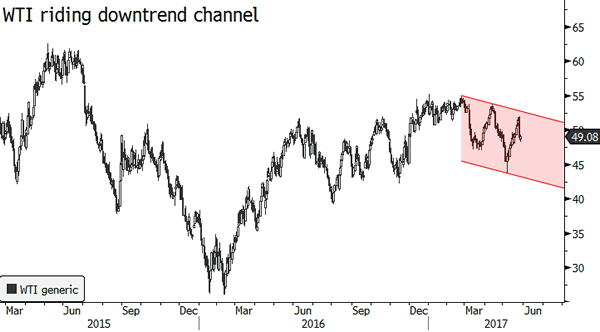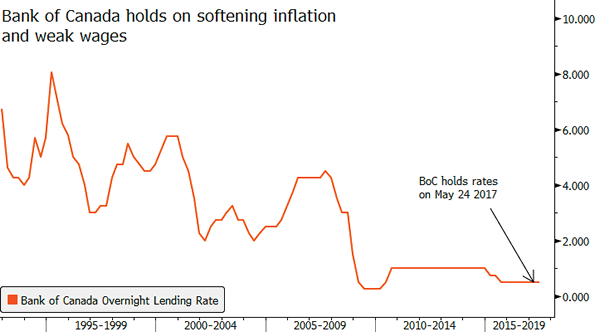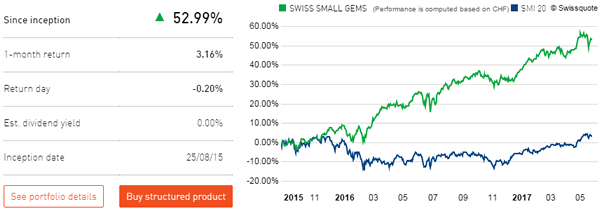- US Data Key To USD Positioning – Peter Rosenstreich
- Crude Oil’s Roller-Coaster Ride – Arnaud Masset
- Canada: Trump And OPEC Send The Loonie Higher – Yann Quelenn
- Swiss Smart Beta
Economics – US Data Key To USD Positioning
The USD failure to hold gains is a clear indication that sentiment around the greenback has shifted. The FOMC 14th June rate decision is expected to bring a 25bp hike, yet following the Feds interest rate tightening cycle becomes subdued. Markets have already shifted away from two additional hikes to possible one in 2017. The fact is that US economic data has not recovery significantly since the soft patch in 1Q, while global economic data has underwhelmed. Suggesting that acceleration for US growth is unlikely. Anticipation for stronger growth in 2H, to a pace of 2%, has been based on expectation for fiscal stimulus, primarily tax reform. Yet, instability in the Trump administration has derailed the near term likelihood of his pro growth policy. Stalling of the US economic story to backstop risk appetite, has exposed markets to rogue bouts of volatility (as seen by markets now reacting to every news headlines). Next weeks US data heavy schedule will be critical for the USD, high beta currencies and stocks with their nose bleed valuations.
First up is consumer data, which needs to remain, elevated to support any chance of hikes after June. Markets and Fed members have been unimpressed with 1Q inflation trend. Income growth has remained marginal in 1Q averaging 0.3% m/m. Given the strong April employment data we should see a stronger increase. Yet continued failure of spillover from tigher labor markets into wage growth will have clear dovish effect on Fed speakers. We could see personal income increase 0.5% m/m, which will encourge the few hawkish members.
Personal consumption expenditure in 1Q was also disappointing. Yet uptick in retail sales should support personal spending. Durable good spending should have also improved after recovery in automotive and parts picked up after 3 months of decline. At the May FOMC members indicated that weakness in PCE was due to transitory factors, such a wireless telephone services.
However, soft incoming data since the meeting indicates that core PCE is unlikely that have rebounded. PPI specifically has failed to meaningfully contribute to core PCE. Taken in its entirely we suspect that balance of risk is for a weaker USD in the near term. We don’t see a substantive shift in the economic data that would support repricing of additional rate hikes. The shallow Fed tightening cycle will keep USD supported just enough to get pushed lower. Traders should watch for sustained higher average volatility in currencies.
Economics – Crude Oil’s Roller-Coaster Ride
After several months of relative quiet trading, crude oil came back under the spotlight as investors anticipated the outcome of the May OPEC meeting. Markets’ expectations were high as the supply cut provided by OPEC members and selected non-members failed to boost durably crude oil prices. Indeed, following the previous OPEC meeting – back in November 2016 – the Cartel agreed to trim output to 32.5 million barrel a day, which correspond to a cut 1.8 million barrel a day. This decision allowed crude oil to rally strongly, with the WTI jumping to around $54. However, the honey moon didn’t last long as the effect of the so-called "output deal" were rapidly put into question by market participants as we get closer to the end of the six months trial period.
On May 25th, the 14 OPEC members and 10 non-members agreed to extend the cut for a further period of nine months, starting July 1st 2017 until the end of the first quarter of 20108. The decision was no surprise and was already priced in the future market. In fact, both the Brent and WTI extended losses after the announcement, suggesting that investors hoped for deeper production cuts. The West Texas Intermediate’s price fell more 7% over the last two days and returned below the $49 threshold, while Brent’s price slid to $50.
As explained in our Weekly Report a couple of weeks ago, we believe this decision is not sufficient to bolster crude oil prices in the medium nor the long-term. The current OPEC strategy is fatally flawed as the US shale industry, which does not participate to the effort, is the primary beneficiary of those production cuts, meaning that the higher the price, the higher the number of profitable US wells.
Once again, the market will enter in to a wait-and-see attitude and assess the effect of the recent extension decision. We expect a few choppy trading session over the next couple of weeks but we remain highly sceptical it will fuelled a rally. The OPEC and its allies need to provide a much larger effort to lift price above the $60 threshold. Extending a deal that had mixed results will not do the job.

Economics – Canada: Trump And OPEC Send The Loonie Higher
Unsurprisingly, Canada’s central bank has decided to keep unchanged its overnight rate target at 0.50%. The Bank Rate is at 0.75% while the deposit rate is at 0.25%.
Financial markets are still expecting the cost of borrowing to stay low for some more time and underpin the housing bubble. Since 2009, the average price of a home has increased by more than 40% in nominal terms.
It is clear that the housing market is a concern. It is way too soon to assess recent measures from the provincial government in Ontario aiming at cooling the real estate market (rent control in particular).
In terms of economic data, annualised inflation (1.6%) is declining and is still below the central bank’s target midpoint. According to the Monetary Policy Report, consumer prices are declining because of the intense retail competition. March retail sales (excluding Auto) are also on the soft side with -0.2% y/y performance.
Canadian policymakers are largely following the US economic recovery. Officials hinted that the benchmark interest rate policy may change when the US economy will rebound further in the second quarter. Anyway, the Canadian central bank is satisfied with the current level of monetary stimulus and seems then very optimistic about the next US Q2 that would allow them to normalize their monetary policy.
Currency-wise, current major CAD drivers are US President Donald Trump and OPEC. The market is pricing in more difficulties for Trump to achieve its reforms. By the way, there are now more bearish pressures on the greenback.
The loonie has been strengthening since the start of this month and is now trading around one-month highs against the US dollar below 1.35. In addition, markets rumours were right, OPEC will continue to cut production beyond June, and for the next nine months, so we believe this is also sending the loonie higher. There is definitely more downside risks on the USDCAD pair.

Themes Trading – Swiss Smart Beta
Switzerland’s stability has provided ideal soil for global brands to develop. The Swiss National Bank’s commitment to hold interest rates negative "for some time" should convince domestic savers to move their savings into stocks while allowing the Swiss franc to further devalue. With a weaker Swiss franc, companies will regain some of the competitive edge they have lost. However, Swiss companies rely more on brand quality and innovation than on pure price competitiveness. Outside the blue chip names are small cap companies that are perfect for value investors, offering a P/E of 15x (compared with 18x for US small caps) and attractive dividend yields.
This theme was built using companies with market capitalizations below CHF 2 billion, P/E less than 18 and used a standard GARP (growth-at-areasonable price) model to uncover the most attractive stocks.













